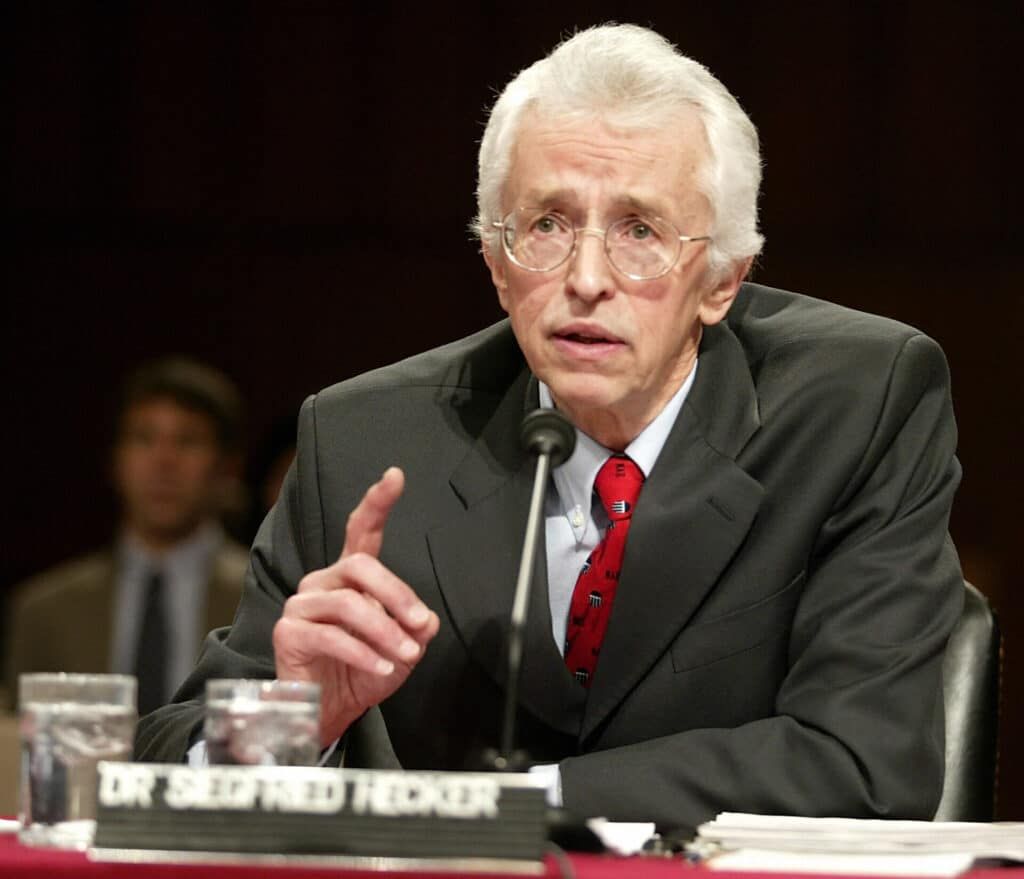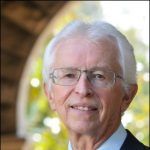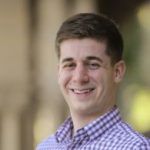An excerpt from “Hinge Points: An Inside Look at North Korea’s Nuclear Program”
By Siegfried S. Hecker, Elliot Serbin | February 20, 2023
 Siegfried Hecker, a Senior Fellow at Los Alamos National Laboratory in New Mexico, testifies before the Senate Foreign Relations Committee 21 January, 2004 on Capitol Hill in Washington, DC. Hecker, who was a member of an unofficial US delegation that visited the controversial Yongbyon research complex this month, told lawmakers that North Korea can accumulate six Kilograms (13.2 pounds) a year of plutonium that could be used to make a nuclear weapon. "The five megawatt reactor has been re-started, it appears to be operating smoothly, providing heat and electricity, also accumulating approximately six kilograms (13.2 pounds) of plutonium per year in its spent fuel rods." Photo credit: Stephen Jaffe/AFP via Getty Images
Siegfried Hecker, a Senior Fellow at Los Alamos National Laboratory in New Mexico, testifies before the Senate Foreign Relations Committee 21 January, 2004 on Capitol Hill in Washington, DC. Hecker, who was a member of an unofficial US delegation that visited the controversial Yongbyon research complex this month, told lawmakers that North Korea can accumulate six Kilograms (13.2 pounds) a year of plutonium that could be used to make a nuclear weapon. "The five megawatt reactor has been re-started, it appears to be operating smoothly, providing heat and electricity, also accumulating approximately six kilograms (13.2 pounds) of plutonium per year in its spent fuel rods." Photo credit: Stephen Jaffe/AFP via Getty Images
Editor’s note: This excerpt serves as the preface to Hinge Points: An Inside Look at North Korea’s Nuclear Program, published by Stanford University Press in January 2023. An interview with the author of the book, Siegfried Hecker, can be read here.
“Would you like to see our product?” asked Dr. Ri Hong Sop, director of North Korea’s Yongbyon Nuclear Complex. He peered at me expectantly from across a table in a small, nondescript conference room. We were inside North Korea’s Radiochemical Laboratory, a massive complex where the North had allegedly extracted the bomb fuel for its nascent nuclear weapons program. “You mean the plutonium?” I replied cautiously, somewhat taken aback by the question. Well, yes, Ri replied and motioned to a colleague in a white lab coat who promptly left the room to retrieve the material. Within minutes, I was holding a nearly half-pound, funnel-shaped piece of plutonium in my hands in a sealed glass jar.
This event was the crowning touch of my first and most improbable visit to North Korea in January 2004. It was nearly 40 years after I had first held plutonium in my gloved hands as a summer student at the Los Alamos laboratory, the birthplace of the nuclear bomb in New Mexico. It was not so much the presence of plutonium that surprised me—although bringing it into a conference room was unusual—but rather that the North Koreans would show their plutonium to me, the former director of the Los Alamos National Laboratory. Perhaps even more surprising, why would their nuclear specialists give me such a revealing tour of their nuclear facilities? As I discovered, they were anxious to show the outside world that their nuclear facilities were operating and what they had accomplished. Although I was visiting with Stanford University Professor John W. Lewis in a non-governmental, unofficial (typically called Track II) capacity, North Korean officials viewed my association with Los Alamos as a valuable conduit to the U.S. government.
I knew my way around nuclear facilities and nuclear weapons, having worked at Los Alamos for several decades, including serving for nearly 12 years as the laboratory’s fifth director. I had visited the nuclear weapons facilities of Russia, China, the United Kingdom and France. Although my expertise was primarily in the technical domain, I was no stranger to political and diplomatic issues, having worked closely with UK and French colleagues to develop cooperative programs to keep the Soviets at bay during the Cold War. As the Soviet Union disintegrated, I worked with Russia and several other former Soviet states to help them mitigate the nuclear security and safety challenges resulting from the Soviet collapse. I had also worked with China’s nuclear complex to assist its nuclear specialists to protect and safeguard their nuclear materials, and later to join forces to help prevent nuclear terrorism. I had also just begun to take a closer look at the India/Pakistan conflict, an antagonistic relationship for over fifty years that had risen to alarming levels after both countries declared themselves nuclear powers after conducting nuclear tests in 1998. North Korea was not on my horizon. I was not keen to visit.
What I saw and experienced during that first visit shattered my preconceived notions about the Democratic Peoples’ Republic of Korea (DPRK). How could a country that ranks in the bottom 10 percent of the world’s economies in which hundreds of thousands of its citizens starved to death in the 1990s possibly muster the means to build the bomb? And now, why did this country, generally viewed as the equivalent of an astrophysical black hole from which nothing can escape, open its main nuclear complex to me and allow its nuclear professionals to brief me on the status and plans for that complex?
Most importantly, the visit alarmed me about how the George W. Bush administration had failed to anticipate the technical consequences and ensuing nuclear security risks of its political decision to walk away from a diplomatic agreement that had halted activities at the nuclear complex for eight years. I reported my findings at a congressional hearing for what marked the beginning of a nearly two-decade endeavor to better assess North Korea’s nuclear program and mitigate the risk it posed to our Northeast Asian allies, South Korea and Japan, and U.S. assets in the region and at home. This journey took me back to North Korea each of the next six years. Each trip brought more information about the nature of the nuclear program, the personalities of my North Korean interlocutors, and the inner workings of their bureaucracy. The surprises never stopped coming.
After my last visit in November 2010, North Korea’s nuclear facilities have been off limits to all outsiders. I watched from afar as the North showed off one nuclear advance after another. I continued to update my technical analysis, followed political developments closely, and provided advice to our government and to allies. I was frustrated by how successive U.S. administrations were not able to prevent a country with such a weak hand from becoming one of fewer than ten countries in the world to possess a nuclear arsenal, and one of only three that might target the United States. My analysis of how this happened, what could have been done differently, and the lessons learned for future administrations is the subject of Hinge Points.
Together, we make the world safer.
The Bulletin elevates expert voices above the noise. But as an independent nonprofit organization, our operations depend on the support of readers like you. Help us continue to deliver quality journalism that holds leaders accountable. Your support of our work at any level is important. In return, we promise our coverage will be understandable, influential, vigilant, solution-oriented, and fair-minded. Together we can make a difference.
















